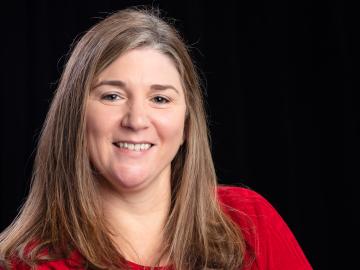
Filter News
Area of Research
- Advanced Manufacturing (14)
- Biological Systems (14)
- Biology and Environment (84)
- Biology and Soft Matter (1)
- Building Technologies (3)
- Chemistry and Physics at Interfaces (5)
- Clean Energy (245)
- Climate and Environmental Systems (2)
- Computational Biology (4)
- Computational Engineering (2)
- Computer Science (4)
- Data (1)
- Energy Frontier Research Centers (8)
- Energy Sciences (2)
- Fossil Energy (2)
- Fuel Cycle Science and Technology (1)
- Functional Materials for Energy (7)
- Fusion and Fission (24)
- Fusion Energy (2)
- Geographic Information Science and Technology (2)
- Isotope Development and Production (2)
- Isotopes (17)
- Materials (238)
- Materials Characterization (2)
- Materials for Computing (13)
- Materials Synthesis from Atoms to Systems (6)
- Materials Under Extremes (6)
- National Security (40)
- Neutron Science (85)
- Nuclear Science and Technology (29)
- Nuclear Systems Modeling, Simulation and Validation (1)
- Nuclear Systems Technology (1)
- Quantum Condensed Matter (1)
- Quantum information Science (1)
- Reactor Technology (1)
- Renewable Energy (1)
- Sensors and Controls (2)
- Supercomputing (116)
- Transportation Systems (5)
News Type
Date
News Topics
- 3-D Printing/Advanced Manufacturing (55)
- Advanced Reactors (12)
- Artificial Intelligence (33)
- Big Data (13)
- Bioenergy (40)
- Biology (42)
- Biomedical (25)
- Biotechnology (11)
- Buildings (21)
- Chemical Sciences (37)
- Clean Water (7)
- Climate Change (36)
- Composites (11)
- Computer Science (70)
- Coronavirus (23)
- Critical Materials (12)
- Cybersecurity (23)
- Decarbonization (33)
- Education (3)
- Element Discovery (1)
- Energy Storage (55)
- Environment (71)
- Exascale Computing (12)
- Fossil Energy (1)
- Frontier (17)
- Fusion (21)
- Grid (22)
- High-Performance Computing (35)
- Hydropower (2)
- Isotopes (28)
- ITER (3)
- Machine Learning (18)
- Materials (64)
- Materials Science (61)
- Mathematics (4)
- Mercury (6)
- Microelectronics (1)
- Microscopy (25)
- Molten Salt (2)
- Nanotechnology (32)
- National Security (34)
- Net Zero (5)
- Neutron Science (57)
- Nuclear Energy (41)
- Partnerships (27)
- Physics (40)
- Polymers (17)
- Quantum Computing (10)
- Quantum Science (28)
- Renewable Energy (1)
- Security (17)
- Simulation (12)
- Space Exploration (3)
- Statistics (1)
- Summit (22)
- Sustainable Energy (43)
- Transformational Challenge Reactor (4)
- Transportation (37)
Media Contacts

Steven Campbell can often be found deep among tall cases of power electronics, hunkered in his oversized blue lab coat, with 1500 volts of electricity flowing above his head. When interrupted in his laboratory at ORNL, Campbell will usually smile and duck his head.

In a finding that helps elucidate how molten salts in advanced nuclear reactors might behave, scientists have shown how electrons interacting with the ions of the molten salt can form three states with different properties. Understanding these states can help predict the impact of radiation on the performance of salt-fueled reactors.

Using neutrons to see the additive manufacturing process at the atomic level, scientists have shown that they can measure strain in a material as it evolves and track how atoms move in response to stress.

Mike Benson has spent the last 10 years using magnetic resonance imaging systems — much as you find in a hospital — to understand the fluid dynamics of flows around objects and even scaled replicas of cities. He aims to apply MRI scanning to

Safety, Engineering and Support Section Head Michele Baker brings strategic planning and emergency management skills to the role.

The Department of Energy’s Oak Ridge National Laboratory and Tennessee State University have signed a memorandum of understanding to strengthen research cooperation and provide diverse undergraduate students enriching educational research opportunities at the lab.

ORNL and the University of Texas Rio Grande Valley, known as UTRGV, have signed a memorandum of understanding to strengthen research cooperation and establish a collaborative program for undergraduate research and education, further cementing hi

Susan Hubbard, diputada de Ciencia y Tecnología en ORNL, Can (John) Saygin, vicepresidente mayor de investigación y decano del Colegio de la Escuela de Postgrados en UTGRV, firman un Memorándum de Entendimiento comprometiéndose a fortalecer

As current courses through a battery, its materials erode over time. Mechanical influences such as stress and strain affect this trajectory, although their impacts on battery efficacy and longevity are not fully understood.

ORNL has been selected to lead an Energy Earthshot Research Center, or EERC, focused on developing chemical processes that use sustainable methods instead of burning fossil fuels to radically reduce industrial greenhouse gas emissions to stem climate change and limit the crisis of a rapidly warming planet.


